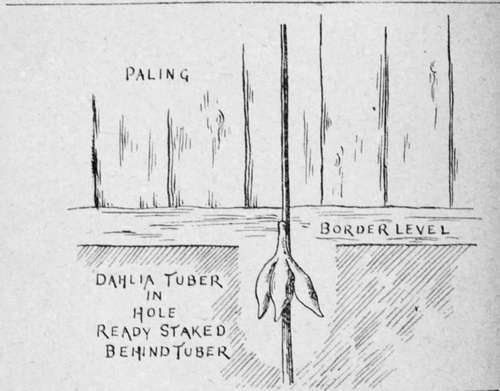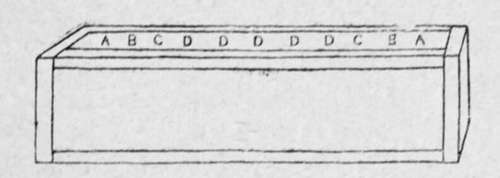Chapter VI. Daily Routine And Seasonable Work
Description
This section is from the book "Town Gardening", by Mary Hampden. Also available from Amazon: Town Gardening.
Chapter VI. Daily Routine And Seasonable Work
General Tasks For May, June And July
PATHS and lawns require rolling after rainy weather, and should be frequently swept with a birch broom, as this removes ant-hills and worm-casts.
Lawn sand can be applied to portions of lawns to destroy weeds, as it works most efficaciously in hot weather. Still a great deal may be done by uprooting dandelions, etc., and transplanting grass ' weeds ' from borders or paths into the holes, after clipping the blades short.
A slight sprinkling of any good fertilizer will do old lawns good, after rain has washed it in. Lawns that are used for games, or much trodden, need watering in seasons of drought if in the open. Tree-shaded lawns are usually damp enough in summer and too damp at other times.
Lawns should be cut twice a week, if possible, but it is usually sufficient to clip the edges once a week, and use the sharp crescent-bladed turf-edge-cutter once a month.
If a lawn is badly worm-infested a solution should be made of one pound of slaked lime in four gallons of water, and left to stand three days. Then the clear liquid must be poured off, free from the sediment, and applied to the turf through a fine-rosed watering-can. If this is done some damp early morning, after a thorough rolling the previous evening, the worms will come up to the surface and may be swept off in quantity.
Rose-trees becoming infested writh green-fly should be syringed after sundown with a solution of four ounces of soft-soap and one dessertspoonful of paraffin in two gallons of water. Next morning, early, they should be syringed with plain water. These operations, repeated three times, with a day's interval between, will cure the pest in almost all eases.
Box edgings can be clipped into shape ; also all clipped evergreens.
The greenhouse plants should be watered with discrimination every evening, and syringed two or three times a week at least.
Plants must be shaded from fierce sunshine through glass roofs, either by whitening the latter, or nailing muslin or tiffany across it, if there is no natural canopy of climbers. Leaves of all pot plants under cover, except 1 wroolly ' leaves, such as those of begonias, geraniums and primulas, should be sponged once a week if large enough. Spraying is always safe.
Any of the fairly robust pot plants, such as geraniums, pelargoniums, heliotrope and hydrangeas, that are infested by insects can be dipped quickly in a solution of four ounces of soft-soap in six gallons of water. This must be done in the evening, as sunshine must not fall on them till they are dry. They rnusi be dipped in plain water the following evening.
A glasshouse that is badly infested can best be made clean and healthy by fumigating it every other evening for six days. There are little vapour cones sold by florists, that only need to be set alight and ieii to smoulaer out, after all doofs and windows have been closed. They should be stood on the stone or brick flooring and used scrupulously according to the special instructions supplied.
Keep dead flowers picked off sweet-peas before seeds can form.
If carnations in the border die off mysteriously sink some partly hollowed-out halves of potatoes, smeared with fat, just below the soil, after sticking a small stick through each to show its whereabouts and enable the trap to be quickly lifted for examination and reburied.
Lay lettuce and cabbage leaves, fat-smeared, downwards on borders to trap slugs.
Place damp hay in' some small pots that have been smeared with grease, and invert them on stakes among the dahlias, hollyhocks, roses, etc.
Water indoor ferns, aspidistras, aralias, etc., more as the weather becomes warmer.
Special Work For May
Plant out young dahlias, or divided sprouting old tubers, late in the month, in very well manured soil, in sunshine, or in rich compost, three plants to a split barrel, or one plant to a ten-inch pot. Examine the tubers carefully before dividing them, to be sure that each piece severed has an ' eye.' However great the pains taken, no divided portion not possessed of an 1 eye ' can sprout, and the ' eyes ' are situated round the collar of the tubers.
Propagate pinks, of the garden hardy sort, by pulling off little shoots with rootlets already forming from the base and old stems, and plant them in lines in semi-shade or at intervals of an inch round the edges of pans or large pots, in cold greenhouses, frames, or stood out of doors. Use sandy compost and keep their foliage sprinkled.

How to Flant Dahlias.
Fill window-boxes, urns, tubs, baskets, etc., for adorning real city houses and gardens, with dwarf miniature-leaved varieties of ivies, Creeping Jenny, London pride, Rose of Sharon, scented-leaved geraniums (which can be often dipped in water), hartstongue ferns, lobelia erinus, musk, and small specimens of berberises, cotoneasters, euonymuses, boxes, Japanese honeysuckle, arbor vitaj, veronica glauca-ceerulea, hypericum patulum, symphoricarpus radicans (the snowberry tree).
Add to actual or artificial borders or beds, at the end of May, calceolarias, geraniums, carnations (from pots), dwarf French marigolds, lobelia erinus, snapdragons, sweet-williams, willow-leaved beet and ordinary crimson beet, early-flowering chrysanthemums, kochia tricophylla (the summer cypress that takes on autumn tints), the common house leek (Sempervivum tectorum), yellow stone-crop (Sedum acre), orange stonecrop (Sedum kamschaticum variegatum), Japanese stonecrop (Sedum spectabile), often two feet tall with heads of rosy flower in late autumn, miniature sweet alyssums, Pigmy dwarf nasturtiums, and variegated arabis and periwinkle for the sake of their leaves. Charming combinations of the above can be made, and the subjects advised for window-boxes, etc., can be used in beds, and those recommended for beds may be tried in boxes, urns, barrels, etc. Many. too. will be useful for pot culture.

Window-Box for not Hiding a Fair View.
A Pink ivy-leaved geranium. Ii Fuchsia procumbens.
C Carmine ivy-leaved geranium. D Pink begonia scmperflorena.
Musk, dwarf lobelias and miniature sweet alyssum will spring up from seed in pots in hot windows even of the Strand, and Cupid sweet-peas have been known to grow from seed (three seeds in a seven-inch pot—seven-inch diameter, of course) in Betlmal Green !
In suburban places there is no danger in using all the usual bedding plants. A consideration of what grows in town parks will teach towrn dwellers that smuts are not to be too much dreaded. Rooftop gardens are the best for plants in crowded districts, owing to there being no walls to draw them up into a thin, lank}7 condition and to exclude air and sun from them. But in the suburbs, verbenas, stocks, asters, marguerites, petunias, begonias, geraniums. Swan river daisies and dwarf snapdragons are but a few of the favourites that will flourish.
Special Work For June
Watch for grubs in the rose buds, and young leaf shoots, and pinch them out, cutting back damaged portions of the branches.
Stand most of the room plants out, in semi-shade, when gentle rain is falling.
Fill the wo/'sZ-situated receptacles or garden ground now, as no frosts need be feared.
Remember that a fine show of Tom Thumb dahlias, from plants bought now, can be had among the stones of a sunny rockery, even if it be but an area slope. These ten-to-twelve-inch dahlias are very bright in effect.
A shady area slope will look cheerful if planted all over with variegated periwinkle, with sunk pot shrubs at intervals, suitable sorts being golden privet and euonymus, and berberis aquifolium. These shrubs should be removed in November and kept growing in cold greenhouses, frames, or rooms.
Shady areas in the suburbs, where houses are not very high and have air-spaces between them, are fit for most of the bedding plants and perennials advised for shady gardens.
Sow some pots of mignonette, thin out to five seedlings in each six-inch pot, keep them outside until September's end, then enjoy the flowers indoors. The seedlings should have their tips pinched off when they are six inches high to encourage bushy growth.
Sow three seeds of the trailing fuchsia (Fuchsia procumbens) in a four-inch pot, under or behind glass. Pot on when roots show at the base. Sink the pot in moss in a hanging wire basket in a sunny window. Beautiful trails of leaf and blossom will result.
Keep dead roses cut off trees.
Continue to bed out, or plant dahlias or chrysanthemums.
Cut down spring-bloomed perennials.
Sow dwarf sweet alyssum over bare spaces on sunny rockeries, or to carpet among tall plants in ornamental garden vases, window-boxes, beds, etc.
Sow wallflowers for next year in a very shallow drill across open ground. Lay down some sweet-pea faggots over the filled-in drill to keep birds off.
Water the garden if there is a spell of drought.
One thorough soaking is right in a week, two are better, but ' a little watering ' done wholesale every evening is disastrous. A portion of a garden can be deluged at a time, another portion the next evening or early morning.
Special Work For July
Tie green-grey wool round the sheaths of opening-carnations that might otherwise burst.
Gather rose petals for potpourri.
Syringe rose-trees that have done their first flowering; cut their branches back that have borne blooms.
Give some old decayed manure as a mulch to the roses, all but those that have not been planted a year.
Give weak liquid manure to dahlias that are growing well; also to roses, hollyhocks, delphiniums, pansies, verbenas, stocks, asters, heliotrope, fuchsias and sweet-peas. Geraniums do not flower well if overfed, but most other bedding plants do better for extra nourishment.
Peg down verbenas and ivy-leaved geraniums.
Lift bulbs of ranunculuses, anemones, tulips, hyacinths, etc., lay them on newspaper in dry sunny sheds or rooms to dry for a week or so, then wipe each and store in perfectly dry sawdust or chaff, or chopped-up baked heather or moss, or old dry broken-up cocoa-nut fibre refuse.
Give sticks and ties to all plants that need them.
Nail loose trails of clunbers to the walls.
Pot some bulbs of freesias in ordinary potting compost, putting them one inch deep and two inches apart, in any sized pots, those of four and a half or five inch diameter being best. Stand the pots in shade in airy rooms, greenhouse or frames, and avoid giving much water : the soil must not get quite dry, but too much moisture will mean failure. More will be required as the plants grow. Bring them into sunshine when growth is a few inches high.
Continue to:
- prev: Chapter V. Seeds, Cuttings, Etc
- Table of Contents
- next: Chapter VII. Keeping Up The Flower Display
